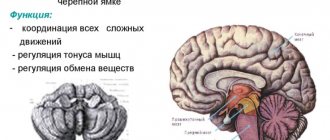The medical term hemianopsia refers to a condition in which there is an area of blindness in half of the visual field. The visual field is the area of space that a person sees without moving his eyes or turning his head. Hemianopsia is a bilateral “partial blindness”, that is, loss of half the field of vision in each eye.
There are various types of this kind of pathology of visual perception. It is possible to distinguish heteronymous hemianopsia (loss of opposite halves of the visual fields), there is also partial, quarter (upper or lower) hemianopsia. “Darkening” of both temporal halves of the field is called bitemporal hemianopia. The loss of parts of the visible space on the side of the nose is binasal hemianopsia. A “blind spot” in the central part of the visual field is called a hemianopic scotoma.
Homonymous hemianopsia is a condition characterized by loss of the same halves of the visual fields. It can be both right or both left halves at the same time: a person can see only one part of the space falling into the field of view (left or right). The boundary between the visible part and the “blind spot” in homonymous hemianopsia is the central vertical meridian.
Types and classifications
As already noted, a distinction is made between right-sided and left-sided homonymous hemianopia.
Right-sided homonymous hemianopsia occurs in cases where the left optic tract is damaged. Left-sided is caused by damage to the right optic tract.
This pathological condition has another classification. Experts highlight:
- Complete homonymous hemianopsia. In this case, the “blind spot” fills half of the visible space, reaching the periphery of the visual field.
- Quadrant homonymous hemianopsia: the visual defect occupies only the upper or lower quarter (quadrant).
- Partial homonymous hemianopsia. This means "darkening" a more local portion of the visual field.
- Scotoma, in which the center of visible space falls out.
Quadrant homonymous hemianopsia can be upper quadrant or lower quadrant, quadrant partial or quadrant complete.
There is also a distinction between congenital homonymous hemianopia and that which developed as a consequence of a number of diseases.
Classification and types of violations
Modern medicine distinguishes several types and subtypes of hemianopsia.
The homonymous form is one of the most common forms
Homonymous anopsia is a pathological condition during the development of which the patient ceases to perceive the right or left area of the visual field.
Homonymous hemianopsia can be either right-sided or left-sided. It occurs due to damage to the cortex of the occipital lobes, with right-sided on the left, and with left-sided on the right.
This pathology is also divided into complete, square and partial. The type of disease depends on which area is affected.
Additionally, this form of the disease is divided into congenital and acquired. Acquired homonymous hemianopia is observed with damage to the central nervous system and brain due to stroke, traumatic brain injury, unsuccessful surgery or tumor.
All this leads to inflammation of the optic nerves. They are compressed, which impairs blood circulation, and they are additionally negatively affected by toxins. In this situation, dysfunction of the visual tracts develops.
Transient homonymous hemiopia is a pathology that is caused by diseases of the cerebral vessels. It is also called transient, because in this case there is a disruption of blood circulation in the vessels of the brain.
In all the situations described, the focus of inflammation has a specific localization. Thus, if the parietal lobe is affected, the person develops inferior quadrate homonymous hemianopsia. Due to damage to the temporal region, superior quadratic or complete form of hemiopia develops.
Signs that indicate the appearance of this disease, in particular after a stroke or other brain damage, are primarily the occurrence of visual hallucinations.
Heteronymous form
Heteronymous hemianopsia is a pathology accompanied by loss of perception of the nasal or temporal areas of the visual field. Here, too, the full, partial and square forms of the disease are distinguished.
Bitemporal form is the most common
Bitemporal hemianopia is characterized by a lack of visibility in the upper parts of the visual field in both eyes. This pathology occurs in patients more often than the previous two. It can lead to:
- damage to the pituitary part where the optical fibers intersect;
- lesion of the medial part of the chiasm.
The location of the blind spot will depend on how much pressure is applied to the chiasm.
Binasal hemiopia
Binasal hemianopsia is a disease that occurs with loss of visibility of the lower, in other words, nasal region of the visual field.
Heteronymous binasal blindness is a pathology accompanied by the simultaneous appearance of several lesions that put pressure on the literal region of the chiasm.
The development of this form of disorder is influenced by chiasmatic arachnoiditis, as well as empty sella syndrome.
The development of pathology in one eye with complete blindness of the second is a disease accompanied by loss of visibility of a portion of the visual field, which spreads only to one eye, with the second becoming completely blind.
This pathology is divided into nasal and temporal. The difference between the latter is that one eye becomes completely blind, and the second one loses the upper half of its field of vision. This condition develops when the optic fibers of the chiasm are completely damaged.
The diagnosis of “nasal hemianopsia” is very rare. Its difference is that in this case the lower half of the visual field falls out.
This condition usually develops over a long period of time. First, partial blindness occurs in both eyes at once. Later, it begins to progress and in case of improper therapy or complete absence of treatment, after some time, the left or right eye becomes completely blind.
Bilateral hemianopsia is a condition in which vision is lost in both eyes at once. In this case, several lesions appear above the chiasma.
A scotoma is a dark area formed in the field of vision. It comes in various shapes. Scotoma has no connection with the peripheral borders, and therefore can manifest itself in absolutely any part of the visual field.
Causes
The appearance of this visual defect is explained by pathology in the area of the optic tract, as well as the cerebral cortex.
Homonymous hemianopsia is a consequence of damage to the areas of the brain that need to receive visual signals. Signals from the right and left eyes are transmitted along the optic nerves in such a way that problems in the left hemisphere of the brain cause “darkening” of the right half of the visual field in each eye; destructive processes in the right hemisphere are a factor causing loss of the left half of the visual fields.
The problem may be explained by a congenital pathology. But it can also be caused by various diseases that affect the brain.
The causes of homonymous hemianopia are most often the consequences of a stroke. But this condition can also be explained by the presence of a tumor, abscess, inflammation, trauma or injury to the head area. Find out about the causes of optic nerve atrophy in the article.
Homonymous hemianopia is caused by an aneurysm of the artery of the base of the brain, circulatory problems in the region of the posterior and middle cerebral arteries, basal meningitis, and meningoencephalitis.
All these conditions can cause the development of an inflammatory process, compression and disruption of the blood supply to the optic nerve fibers. Toxins also have a pathogenic effect on nerve fibers. After some time, under the influence of these factors, the visual tract is gradually destroyed.
Depending on what type of homonymous hemianopsia is detected in the patient, the specialist determines the specific location of the lesion. For example, inferior quadrant homonymous hemianopsia develops in case of problems that arise in the parietal lobe of the brain. The disease, localized in the temporal lobe, causes manifestations of complete upper quadrant hemianopsia.
Symptoms of hemianopsia
At the initial stage of development, there are usually no symptoms of hemianopsia. A visual defect can be detected during a routine examination by an ophthalmologist. As the disease progresses, a person experiences temporary loss of visual fields, which significantly impairs his quality of life.
With this disorder, the patient has difficulty recognizing objects.
He may not recognize people or become disoriented in space. If orientation remains within normal limits, the person denies the presence of visual problems. At the same time, he fixates on a certain point and does not notice anything around him. As the disorder develops, there is a risk of the following signs appearing:
- visual hallucinations;
- high sensitivity to light;
- optic nerve atrophy;
- light flashes in the eyes.
In addition to typical manifestations, a person’s ability to work decreases, problems arise with orientation in space, and difficulties appear in performing ordinary household chores.
The congenital form of the disease is accompanied by impaired pain sensitivity and temperature perception. There is also a risk of paresthesia. The first symptoms of the abnormal process in most cases occur after a stroke. Additional signs of the disorder include fainting, migraines, and deterioration in motor activity of the limbs.
Symptoms
Homonymous hemianopsia may sometimes not be noticeable to the patient. Homonymous hemianopia has no effect on visual acuity. Visual defects in some cases are detected only during visual field examination. Manifestations of this type of hemianopsia are loss of the temporal part of the visual field on one side, and the nasal part on the other. Sometimes half of the visual field disappears completely (complete hemianopia). In some cases, the “darkening” does not reach the periphery of the visual field (incomplete hemianopsia). You can learn about loss of visual fields here.
Cases have been observed in which the remaining half of the visual field slightly “overlaps” the blind side.
Homonymous hemianopsia can make it difficult for a person to move around. People, in some cases, encounter obstacles located on the side of the “dropped out” half of the field of vision. It is almost impossible for the patient to drive a car or distinguish objects located in the “blind spot” of the table. Visual defects make reading difficult: the reader cannot find a new line in a book. Conditions of this kind may not be permanent.
Sometimes a symptom of homonymous hemianopia can be a visual hallucination. This disorder manifests itself especially often in cases where loss of part of the visual field develops after a stroke.
Features of treatment
Therapy for any type of hemianopsia is based on eliminating the diseases that provoked the appearance of lost visual fields.
To treat the disease due to brain damage, surgery is required.
When the optic tract is damaged due to traumatic brain injury, neurosurgical intervention is generally required. In case of ischemic stroke, thrombolysis is performed to eliminate hemianopia in the first 5-6 hours, then conservative treatment is used to reduce blood viscosity. Often after a stroke, the patient sees worse in only one eye, so the functions of the visual system can be restored using medications and special exercises. Left- or right-sided hemianopsia, which is observed with damage to the brain vessels and the development of tumor processes, is treated surgically using radiation and chemotherapy.
The congenital form of the disease is generally not treatable. A patient with such a pathology needs rehabilitation that ensures his connection and contact with the external environment. The rehabilitation specialist teaches the patient special eye movements in the direction of the disappeared field of vision and exercises that help fix vision at various distances. The use of specific devices in the form of mirrors and prisms in glasses helps to partially, and sometimes completely, normalize and improve pathological deviations. They allow you to see blind areas when you shift your gaze to the missing side.
Diagnostics
The violation can be determined after studying the state of three important features of the functioning of the visual organs:
- visual acuity;
- fields of view;
- ophthalmoscopy.
The defect can be detected by visual field testing. The neurological technique includes an indicative test of the visual fields, which the doctor conducts during the examination. A specialist can detect smaller problems of visual perception using conventional or computer perimetry.
To diagnose visual field defects in ophthalmology, visual field analyzer devices (for example, campimetry) are used. Their use makes it possible to study the light and color sensitivity of the visual system. Instruments are also used to study the flicker sensitivity of the visual analyzer.
The doctor can make a final diagnosis based on obtaining a complete picture of the fundus, as well as accompanying neurological symptoms.
To determine the exact causes of a visual disorder, it is important to do an X-ray and CT scan of the brain. The doctor may also prescribe a more complete examination and a series of tests that will help make a diagnosis.
Complications and prognosis
By itself, bilateral hemianopsia is not life-threatening. But some diseases that cause it can be fatal - traumatic brain injury, severe stroke.
The prognosis for disability depends on the causative factor of the disorder, the degree of damage, and the amount of vision loss. With a slight loss of visual fields and comprehensive rehabilitation, a person with a homonymous disorder can lead a normal lifestyle.
Complications of hemianopsia include possible traumatization of a person due to insufficient perception of the surrounding world. As the causative disease progresses, complete loss of vision is possible.
Treatment
To get rid of problems of visual perception, it is necessary to completely eliminate the consequences of the diseases that caused homonymous hemianopia. If treatment of the underlying disease is ineffective and untimely, hemianopia can lead to complete loss of vision.
To eliminate neurological pathologies, surgical treatment, chemotherapy, and drug therapy are used, depending on the type and degree of complexity of the underlying problem.
Loss of visual fields with hemionopsia
Hemianopsia practically cannot be cured, however, after eliminating the factor that causes it, a number of methods can be used to improve the patient’s quality of life. For example, a person suffering from homonymous hemianopsia can learn to read by holding text at a 90° angle and viewing it vertically.
There are also a number of recommendations to make moving in space easier.
Hemianopsia: treatment
Hemianopsia is a disease that is associated with the eyes, but is treated not by an ophthalmologist, but by a neurologist.
If, when visiting a doctor, it is possible to accurately diagnose this particular disease, the patient will be referred to a neurologist who will eliminate not just the symptoms of the disease, but its root cause.
After this, the hemianopia will go away.
They can determine the presence of certain pathologies in the form of a benign or malignant tumor.
There are three treatment options for hemianopsia:
- chemotherapy;
- X-ray therapy;
- surgical intervention.
Conservative therapy is not considered in this case, since even with long-term treatment in this way, there is practically no effectiveness.
However, if you do not want to undergo surgery, you can follow certain recommendations that relate specifically to conservative medicine.
Such tips will help improve visual acuity and, in some cases, increase the viewing angle. Ophthalmologists and neurologists recommend the following:
- when reading books, it is advisable not to rotate your head, but to keep it stationary and move your eyes, and the greater the range of space covered by the eyes, the better;
- when reading, it is necessary to abandon traditional ways of perceiving information, and read not horizontally, but vertically, turning the book, newspaper or magazine 90 degrees;
- Considering that hemianopsia most often develops in one eye, when walking with the patient it is better to walk next to him, holding his arm on the side on which the disease develops.
In recent years, special computer programs have been used to treat this disease, which help expand the range of vision in some cases.
But such software has not yet been certified, so it is too early to talk seriously about the effectiveness of this method.
conclusions
Hemianopsia is a defect of visual perception in which loss of half the visual field develops in each eye. This condition is caused by factors associated with damage to the areas of the brain that receive visual signals. Read more about hemianopia in this material.
Treatment of hemianopsia is carried out depending on the nature of the underlying disease.
Hemianopsia can be temporary or permanent. This is explained by the severity of the damage to the visual pathway.
If untimely or poor-quality treatment is used, pathological processes can lead to complete loss of vision and, consequently, disability.
Kinds
There are two types of disease - homonymous and heteronymous, which are divided into several subtypes.
Homonymous hemianopia is divided into:
- quadrant - with this form, the lower or upper field of vision is lost (develops due to damage to the ventral part of the optic tract, the reason lies in partial damage to the fibers of the Graciole bundle);
- contralateral - the patient does not see anything that is in the area of the nose of one eye and the temporal part of the other;
- right-sided and left-sided - depending on the side of the optic tract lesion.
Heteronymous is divided into binasal and bitemporal forms. Binasal - occurs due to compression of the chiasm. It develops during an inflammatory process in the area of the arachnoid membrane and hydrocephalus associated with oncology.
Bitemporal - a violation of the temporal halves of the visual fields, appears when there is a violation of the middle of the interweaving of two optic nerves.
There is a classification according to the place of prevalence and localization - complete, partial, scotoma.











